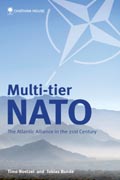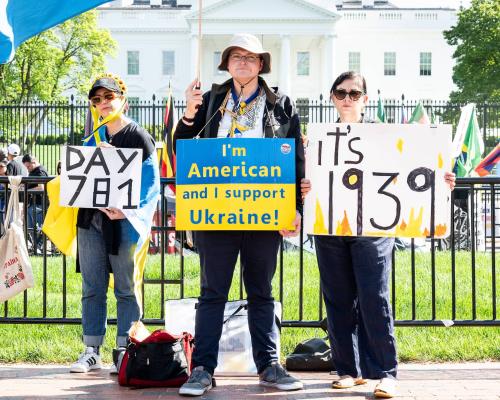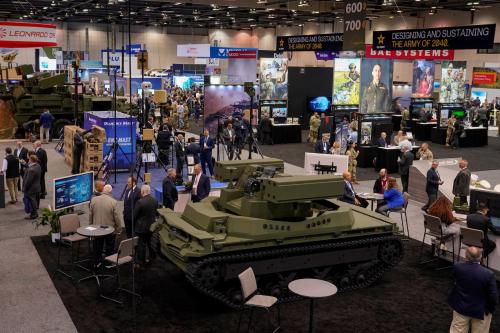“I can’t imagine any conflict that we would be involved with in the future being narrowly focused in one region. It would have transregional implications right away and then multifunctional [ones]” General Joseph F. Dunford, chairman of the joint chiefs of staff, told a Brookings audience this week while discussing global threats, Defense Department requirements, and American national security priorities.
In his conversation with Brookings Senior Fellow Michael O’Hanlon, co-director of the Center for 21st Century Security and Intelligence, General Dunford described the “4 + 1 framework” that guides not only prioritization of countries and groups (e.g., Russia, China, North Korea, Iran, and transnational violent extremism), but also the kinds of capabilities and flexibilities the U.S. needs to prepare for challenges this century. Watch:
O’Hanlon asked Gen. Dunford if he could add a sixth threat to this list, what would it be? Gen. Dunford replied: “solvency.”
“We all recognize that the economic strength of our nation is the foundation that we have to build military capability and advance security,” Gen. Dunford said. “So just speaking about it strictly in a national security context, our capabilities and capacities—that is what we can do and how much we have to do it with—are inextricably linked to the strength of our economy and the stability of the budgets that we have.“
US COMMITMENT TO NATO
Gen. Dunford elaborated on a number of the most pressing national security and defense challenges of the day, including NATO, Russia, China, Iran, and Syria.
Recognizing the statements made by top U.S. officials in Europe recently, including Vice President Mike Pence, Defense Secretary James Mattis, and State Department chief Rex Tillerson, Dunford was unequivocal: “I don’t think there is any question about our commitment to NATO.” However, he reiterated two other points that have been voiced by the new administration in Washington: “more equitable burden sharing” where NATO members meet agreed-upon 2 percent of GDP targets for defense spending, and also making sure that NATO meets both state- and non-state challenges. Watch:
“This is all about transforming NATO to be relevant to meet the security challenges which we confront today,” he added. “A recognition that in order to remain viable, in order to remain credible, in order to deter conflict in Europe, we need to make sure that NATO meets its requirements for defense spending.”
ON RUSSIA
Russia under the leadership of its president, Vladimir Putin, presents the U.S. and international community with unique challenges, from its involvement in the Syrian conflict, to supporting separatists in eastern Ukraine, to meddling in democratic processes in Europe and the United States. Gen. Dunford offered his assessment of Russia’s current capabilities and operation patterns, which include modernization of its maritime and cyber capabilities, and operating “below the threshold of conflict” through unconventional tactics, cyber, economic coercion, and political influence, which he says are aimed to “undermine our ability to meet our commitments to the NATO alliance.” He also characterized his recent meeting with his Russian counterpart General Valery Gerasimov as intended to “to make sure that we mitigated the risk of miscalculation and we opened up lines of communication that would be effective in the event of a crisis or contingency.”
CHINA AND THE PACIFIC
Over the past few years, China has asserted itself economically and militarily in the Asia-Pacific region, including building up potential military bases on disputed islands in the South China Sea. General Dunford emphasized that we are unlikely to have to use force against China in the disputed areas, noting what Secretary Mattis recently said, that “these territories which are contested need to be addressed politically through a legal framework consistent with international law.”
He spoke more broadly to the fact that U.S. military posture in the Pacific region is not only about the South China Sea, but “as a whole is designed for our broader interest, one of which is the peaceful resolution of territorial disputes.” Also, to deter conflict, to set conditions for economic and cultural interests, and to maintain U.S. and the international community’s “right of navigation” throughout the region. Watch:
IRAN: A MALIGN INFLUENCE IN THE REGION
Iran’s support of factions in various conflicts around the Middle East, including Houthi rebels in Yemen Assad’s government in Syria, and Hezbollah fighters based largely in Lebanon, continues to present significant challenges to U.S., regional, and allied interests. The Joint Chiefs chairman stated that “the major export of Iran is actually malign influence across the region.” He continued:
They have got a very aggressive proxy war. We see that in Yemen. We see their influence in Syria. We see their malign influence in Lebanon, as well in Iraq and the rest of the region. … This is a pattern of behavior that has manifested itself over many years. As to what economic or political measures may be taken to moderate Iran’s behavior, I’ll leave that to others. My lane is the military dimension, and so what we have made sure is that within the U.S. Central Command that has responsibility for Iran, our military posture is there to make sure we have freedom of navigation through the Straits of Hormuz, and that we deter conflict and crisis in the region, and that we advance our interest to include our interest in dealing with violent extremism of all forms.
OPTIONS FOR SYRIA
The civil war in Syria has raged since 2011, causing the deaths of hundreds of thousands of people and forcing millions of Syrians to flee into neighboring countries, to Europe, and some to the United States. Maintaining his focus on transregional threats, Gen. Dunford spoke to the promise that Donald Trump had made as a presidential candidate to conduct a 30-day review of options for Syria. Whatever the time frame, Gen. Dunford emphasized that “this plan is a political-military plan” that includes engagement “at every level” with the State Department, and also the intelligence community and the Treasury Department. “Not only will this be a whole of government approach,” he said, but it’s also “about a trans-regional threat,” including focus on ISIS, al-Qaida, and others—not just about Syria and Iraq. He explained the nature of this threat and what a successful plan looks like:
Ultimately, Gen. Dunford stressed that as he and others provide options to the president of the United States, the battlefield realities and competing powers will inform the diplomatic process. “We need to think about:
how do the facts on the ground support the political process in Geneva that is going to address the long term and stability and security inside Syria? The grievances of the civil war have to be addressed, the safety and humanitarian assistance that needs to be provided to people have to be addressed, and the multiple divergent stakeholders’ views [i.e., the Syrian regime, Iran, Russia, Turkey, the Kurds, Arabs, Sunnis, Shias] need to be addressed. …
We do need to have a vision of how our military actions set conditions on the ground that actually then become the platform from which Secretary Tillerson goes to Geneva to come up with a political solution. All those variables have to be addressed.
Watch the full event here.
O’Hanlon and the center hosted a related event earlier in the week, Defense priorities for the Trump administration.
Sumita Tellakat contributed to this post.






Commentary
Joint Chiefs Chairman Dunford on the “4+1 framework” and meeting transnational threats
February 24, 2017